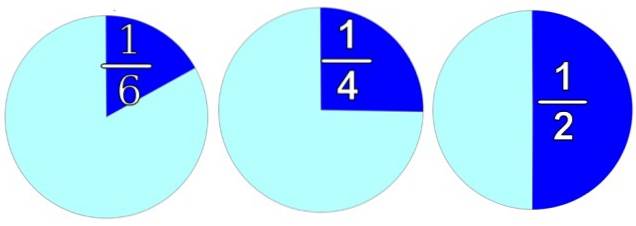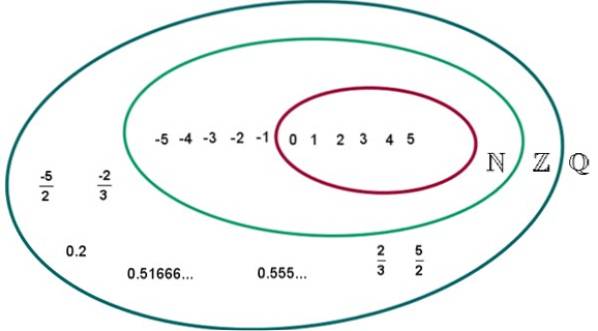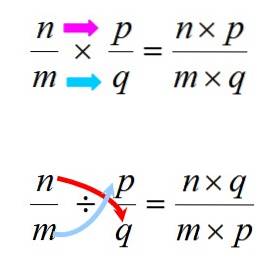
Rational numbers properties, examples and operations
The rational numbers are all the numbers that can be obtained as the division of two whole numbers. Examples of rational numbers are: 3/4, 8/5, -16/3 and those that appear in the following figure. In a rational number the quotient is indicated, being possible to do it later if required.
The figure represents any object, round for convenience. If we want to divide it into 2 equal parts, as in the right, we have two halves left and each one is worth 1/2.

By dividing it into 4 equal parts, we will obtain 4 pieces and each one is worth 1/4, as in the image in the center. And if it is necessary to distribute it in 6 equal parts, because each part would be worth 1/6, which we see in the image on the left.
Of course, we could also divide it into two unequal parts, for example we could keep 3/4 parts and save 1/4 part. Other divisions are also possible, such as 4/6 parts and 2/6 parts. The important thing is that the sum of all the parts is 1.
In this way, it is evident that with rational numbers you can divide, count and distribute things like food, money, land and all kinds of objects in fractions. And thus the number of operations that can be done with the numbers is expanded.
Rational numbers can also be expressed in decimal form, as can be seen in the following examples:
1/2 = 0.5
1/3 = 0.3333…
3/4 = 0.75
1/7 = 0.142857142857142857…
Later we will indicate how to go from one form to another with examples.
Article index
- 1 Properties of rational numbers
- 2 Examples of rational numbers
- 2.1 Decimal representation of a rational number
- 3 Operations with rational numbers
- 3.1 - Addition and subtraction
- 3.2 - Multiplication and division
- 4 References
Properties of rational numbers
Rational numbers, whose set we will denote with the letter Q, have the following properties:
-Q includes the natural numbers N and the whole numbers Z.
Taking into account that any number to It can be expressed as the quotient between itself and 1, it is easy to see that among the rational numbers there are also natural numbers and integers.
Thus, the natural number 3 can be written as a fraction, and also -5:
3 = 3/1
-5 = -5/1 = 5 / -1 = - (5/1)
In this way, Q is a numerical set that includes a greater number of numbers, something very necessary, since the "round" numbers are not enough to describe all the possible operations of doing.
-Rational numbers can be added, subtracted, multiplied and divided, the result of the operation being a rational number: 1/2 + 1/5 = 7/10; 1/2 - 1/5 = 3/10; (1/2) x (1/5) = 1/10; (1/2) ÷ (1/5) = 5/2.
-Between each pair of rational numbers, another rational number can always be found. In fact, between two rational numbers there are infinite rational numbers.
For example, between the rationals 1/4 and 1/2 are the rationals 3/10, 7/20, 2/5 (and many more), which can be verified by expressing them as decimals.
-Any rational number can be expressed as: i) a whole number or ii) a limited (strict) or periodic decimal: 4/2 = 2; 1/4 = 0.25; 1/6 = 0.16666666…
-The same number can be represented by infinite equivalent fractions and all of them belong to Q. Let's see this group:

They all represent the decimal 0.428571 ...
-Of all the equivalent fractions that represent the same number, the irreducible fraction, the simplest of all, is the canonical representative of that number. The canonical representative of the example above is 3/7.

Examples of rational numbers
-Proper fractions, those in which the numerator is less than the denominator:

-Improper fractions, whose numerator is greater than the denominator:

-Natural numbers and whole numbers:

-Equivalent fractions:


Decimal representation of a rational number
When the numerator is divided by the denominator, the decimal form of the rational number is found. For example:
2/5 = 0.4
3/8 = 0.375
1/9 = 0.11111…
6/11 = 0.545454…
In the first two examples, the number of decimal places is limited. This means that when the division is done, we finally get a remainder of 0.
On the other hand, in the next two, the number of decimal places is infinite and that is why the ellipsis are placed. In the latter case there is a pattern in the decimals. In the case of the fraction 1/9, the number 1 is repeated indefinitely, while in 6/11 it is 54.
When this happens, the decimal is said to be periodic and is denoted by a caret like this:


Transform a decimal to a fraction
If it is a limited decimal, the comma is simply eliminated and the denominator becomes the unit followed by as many zeros as there are figures in the decimal. For example, to transform the decimal 1.26 into a fraction, write it like this:
1.26 = 126/100
Then the resulting fraction is simplified to the maximum:
126/100 = 63/50
If the decimal is unlimited, the period is first identified. Then these steps are followed to find the resulting fraction:
-The numerator is the subtraction between the number (without a comma or caret) and the part that does not carry the circumflex accent.
-The denominator is an integer with as many 9 as there are figures under the circumflex, and as many 0 as there are figures in the decimal part there are not under the circumflex.
Let's follow this procedure to transform the decimal number 0.428428428… into a fraction.
-First, the period is identified, which is the sequence that repeats: 428.

-Then the operation of subtracting the number without comma or accent is done: 0428 from the part that does not have a circumflex, which is 0. It is thus 428 - 0 = 428.
-The denominator is constructed, knowing that under the circumflex there are 3 figures and all are under the circumflex. Therefore the denominator is 999.
-Finally the fraction is formed and simplified if possible:
0.428 = 428/999
It is not possible to simplify more.
Operations with rational numbers
- Add and subtract
Fractions with the same denominator
When the fractions have the same denominator, adding and / or subtracting them is very easy, because the numerators are simply added algebraically, leaving the same of the addends as the denominator of the result. Finally, if possible, it is simplified.
Example
Carry out the following algebraic addition and simplify the result:

The resulting fraction is already irreducible.
Fractions with different denominators
In this case, the addends are replaced by equivalent fractions with the same denominator and then the procedure already described is followed.
Example
Add algebraically the following rational numbers, simplifying the result:

The steps are:
-Determine the least common multiple (Lcm) of the denominators 5, 8 and 3:
lcm (5,8,3) = 120
This will be the denominator of the resulting fraction without simplifying.
-For each fraction: divide the LCM by the denominator and multiply by the numerator. The result of this operation is placed, with its respective sign, in the numerator of the fraction. In this way, a fraction equivalent to the original is obtained, but with the LCM as the denominator..
For example, for the first fraction, the numerator is constructed like this: (120/5) x 4 = 96 and we get:

Proceed in the same way for the remaining fractions:



Finally, the equivalent fractions are substituted without forgetting their sign and the algebraic sum of the numerators is carried out:
(4/5) + (14/8) - (11/3) + 2 = (96/120) + (210/120) - (440/120) + (240/120) =
= (96 + 210-440 + 24) / 120 = -110 / 120 = -11/12
- Multiplication and division
Multiplication and division are done following the rules shown below:

In any case, it is important to remember that multiplication is commutative, which means that the order of the factors does not alter the product. This does not happen with division, so care must be taken to respect the order between dividend and divisor.
Example 1
Carry out the following operations and simplify the result:
a) (5/3) x (8/15)
b) (-4/5) ÷ (2/9)
Answer to
(5/3) x (8/15) = (5 x 8) / (3 x 15) = 15/120 = 1/8
Answer b
(-4/5) ÷ (2/9) = (-4 x 9) / (5 x 2) = -36 / 10 = -18/5
Example 2
Luisa had $ 45. He spent a tenth of it buying a book and 2/5 of what was left on a t-shirt. How much money does Luisa have left? Express the result as an irreducible fraction.
Solution
The book cost (1/10) x $ 45 = 0.1 x $ 45 = $ 4.5
Therefore, Luisa was left with:
45 - 4.5 $ = 40.5 $
With that money Luisa went to the clothing store and bought the shirt, the price of which is:
(2/5) x $ 40.5 = $ 16.2
Now Luisa has in her portfolio:
40.5 - 16.2 $ = 24.3 $
To express it as a fraction it is written like this:
24.3 = 243/10
That is irreducible.
References
- Baldor, A. 1986. Arithmetic. Codex Editions and Distributions.
- Carena, M. 2019. Mathematics Manual. National University of the Litoral.
- Figuera, J. 2000. Mathematics 8. Ediciones Co-Bo.
- Jiménez, R. 2008. Algebra. Prentice hall.
- The rational numbers. Recovered from: Cimanet.uoc.edu.
- Rational numbers. Recovered from: webdelprofesor.ula.ve.



Yet No Comments